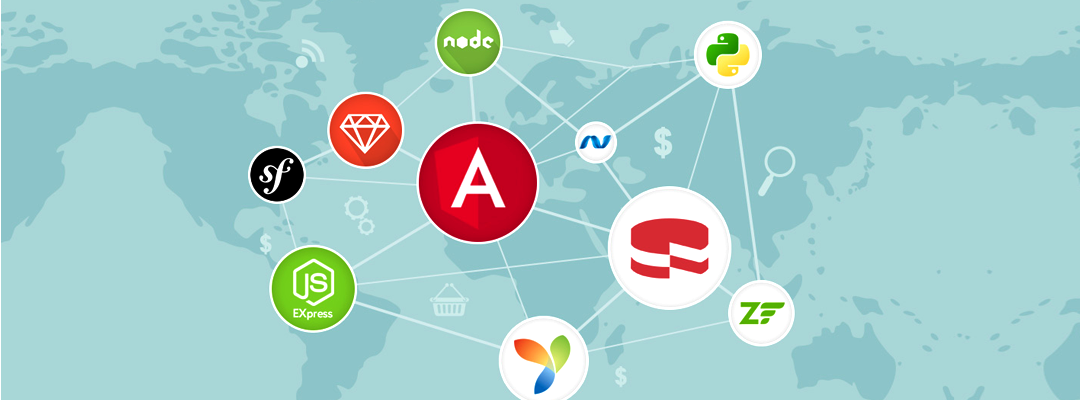Just imagine: your team has put in several months of hard work to develop a prototype and an MVP, and is now ready to show the public the full version of your web application. The initial response is phenomenal, the buzz starts building around it, customers are referring the app to their friends and family, and the user base is growing. Your start-up appears to be doing well – except it isn’t.
With increasing workload, your web application starts slowing down or in the worst-case scenario, it even crashes. The users start switching to other apps due to the deteriorating UX. All of this happens because you didn’t prepare to scale up at the development stage.
What does this suggest? You need to make your startup future-proof by ensuring that your core product is scalable from the very beginning.
What Is Web Application Scalability?
Scalability refers to an application’s capability to adjust to the desired capacity and handle an increasing amount of work without disrupting the user experience. In other words, a scalable web application is an application that effortlessly handles large volumes of data and delivers impeccable performance, regardless of the load changes.
In general, there are two approaches to future-proof your web application: vertical scaling (scaling up) and horizontal scaling (scaling out). The former involves boosting the power of an existing machine, e.g., by increasing RAM or disk capacity. The latter refers to expanding your resources with more machines. Scalability can also be measured over several dimensions, the most prominent out of all is functional scalability which is considered as the app’s potential for further development.
Architecture
You need to start with two steps to develop a scalable web app correctly. The first step is to make the right architecture-related choices about storage, language, hosting, and framework. The second step is to learn how to unleash the full potential of the solutions you have chosen.
Storage
The foremost step is to choose a proper database engine and design the best possible schema. You have two options for selecting a database. One is to choose a NoSQL database, which not only scales well but is also resilient and high-performing. In this case, our top pick is MongoDB. The other option is an SQL database and we recommend going for Oracle.
Once your web application starts growing, you might want to think of replicating your database i.e., creating a couple of instances of the database, each of which is responsible for one CRUD operation. When your web application grows further, it’s time for you to think about sharding i.e., allowing larger datasets to be split into smaller units and stored in multiple data nodes which leads to an increased total storage capacity of the system.
Hosting
After storage, your next decision should be in regards to server infrastructure and configuration. We recommend keeping your code in the cloud solutions such as AWS or using Docker. You can easily containerize your application using Docker. It is important to automate, the creation, configuration, management, and disposal of docker containers from top to bottom. You can scale applications both horizontally and vertically with docker, depending upon your needs.
Another cloud solution is AWS. Amazon offers several tools for system administrators and developers looking to improve scalability. AWS Application Auto Scaling adjusts the capacity of the application to ensure smooth performance at the lowest possible cost.
Languages
If you’re in need of developing a scalable web app fast, it’s crucial to use languages that have stood the test of time, boasted bigger communities, and had better support. Hence, for the frontend, we suggest considering JavaScript/React or JavaScript/Angular. Whereas for the backend, we recommend the Python/Django REST Framework.
CI/CD
The CI/CD approach consists of three elements: continuous integration, continuous delivery, and continuous deployment. CI/CD ensures frequent, fast deliveries and fewer bugs due to the ongoing automation in all stages of development. Software engineers are coding simultaneously which does speed up the work but it also poses a risk of errors in the application. In case it happens, the Application of CI/CD helps overcome the problem of spending long hours integrating the pieces that had been made separately by developers.
The following conditions should be met when introducing CI/CD into the development cycle:
• Using mature, battle-tested development processes
• Leveraging proper services (such as AWS) and tools (e.g., Jenkins or GitLab)
• Using a separate server or platform for continuous integration which will perform the tests automatically within minutes
• DevOps engineers with skills and experience to handle the implementation and manage the further application of the process
Performance
Performance optimization is getting more important with every passing day. The users want a fast, highly interactive, and smooth experience. It is a difficult task, especially, when your business is constantly scaling. However, there are several optimization practices that can help you enhance the app’s performance remarkably.
Switching From Synchronous to Asynchronous Communication
Synchronous operations require a given task to be completed or waiting for a response before moving on to the next one. Whereas asynchronous operations help avoid the bottleneck of having to wait for one function call to finish or for a certain task to be executed before continuing to the rest of the program. This comes in handy when your product starts growing and receiving requests from multiple users at once. In such a scenario, asynchronous helps enhance performance by shortening the total execution time.
Page Load Time
It is defined as the time it takes for website or app page content to completely show up on your screen. The page load time can be reduced by:
• Resize and compress the images, and select the format that best suits your needs.
• Uninstall the outdated or unnecessary plugins as they slow down the web apps
• Keep the CSS and JavaScript codes in external files otherwise, it initiates download whenever a page is requested.
• Reduce redirects to minimize the time needed for a page to load. When an application is forced to redirect to a new URL, it generates new requests leading to more loading time.
• Reduce the cookie size as they’re sent on every request and get stored on the user’s browser to record browsing activities.
Caching
With caching you can temporarily store reusable data to serve the requests fast and effectively. It is a fast and easy way to retrieve data rather than always having to go back to the original source. You can cache images, logos, downloadable pieces of content, media files HTML pages, JavaScript files, or even database queries.
Fine-Tune The Database
It is time to look for solutions to speed up your database if your queries are taking too long to be resolved. Define which data users will most frequently search or sort. You can create indexes based on it in your database. Rather than asking for the whole table, query only the data you need and ask for particular fields. You can also try giving the client paginated results, rather than everything at once.
Conclusion
Users are getting more demanding with time and they expect flawless performance and user experience. This means if you are building a web application aimed to succeed in the market in the longer run, you must focus on making it scalable, improving its performance without increasing complexity, and enhancing its ability to manage more requests per minute. Otherwise, you will lose your credibility, the performance will deteriorate over time and users will switch to your competitor’s app in no time.
We at Golpik believe that multiple factors need to be taken into consideration when it comes to significant web application scalability. We build custom web applications that can cope with increased demand flawlessly.









